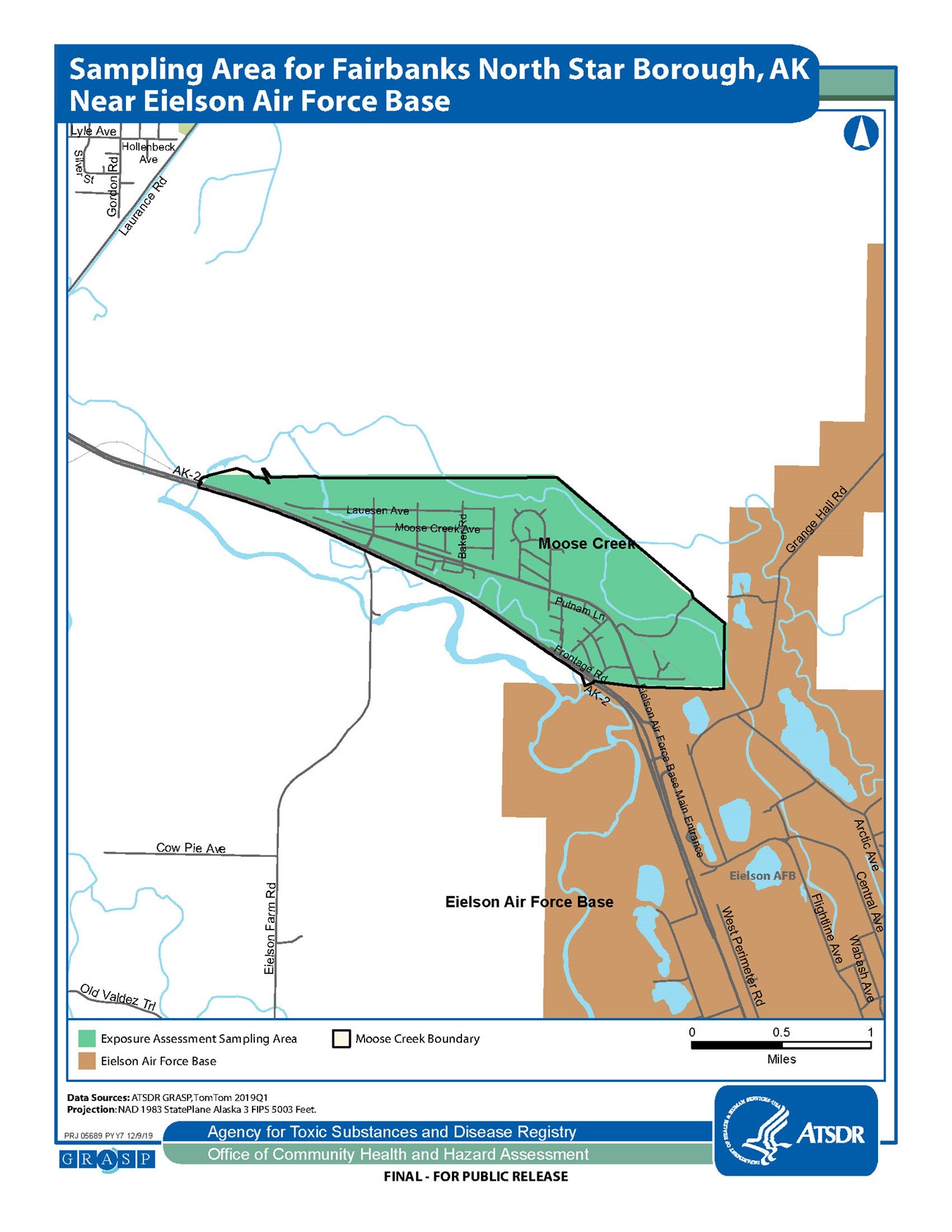Key points
- Water supply for 174 of 192 properties in Moose Creek meets all federal and state guidelines for PFAS in drinking water.
- The other 18 properties within Moose Creek should use alternative water sources provided by the Air Force.
- Follow this recommendation until connected to the North Pole water distribution system.

Background
In 2020, the Centers for Disease Control and Prevention (CDC) and the Agency for Toxic Substances and Disease Registry (ATSDR) conducted an exposure assessment (EA) in Moose Creek, located in Fairbanks North Star Borough, AK, near Eielson Air Force Base.
CDC and ATSDR sent the individual test results to participants and released summary results to the community in February 2021. The PFAS exposure assessment report was released in May 2022.
Why Moose Creek was selected
Use alternative sources of water.
At this time, ATSDR recommends community members continue to use the alternative sources of water provided by the Air Force.
When selecting EA sites, ATSDR considered the:
- Extent of PFOA and PFOS contamination in drinking water supplies.
- Duration that exposure may have occurred.
- Number of potentially affected residents.
Moose Creek was one of several sites nationwide identified with per- and polyfluoroalkyl substances (PFAS) drinking water contamination. This is from use of products such as aqueous film forming foam (AFFF).
As early as the 1980s, Eielson Air Force Base (the Base) used AFFF containing PFAS for its firefighter training. Over time, the PFAS from the AFFF:
- Soaked into the ground.
- Moved into the groundwater to offsite locations.
- Affected nearby private wells in Moose Creek.
PFAS were first detected in private wells downgradient of the Base in May 2015. To reduce levels of PFAS in drinking water, the Air Force immediately began providing bottled water to Moose Creek households served by the affected wells. The Air Force eventually used other mitigation efforts, including:
- Underground storage tank installation.
- Above-ground storage tank installation.
- Bottled water delivery services.
- Whole-house granulated activated carbon filtering systems.
Based on information available to ATSDR, the alternative drinking water provided by the Air Force currently meets or is below the U.S. Environmental Protection Agency's (EPA) 2016 health advisory (HA). It also meets or is below state public health guidelines for PFAS in drinking water. This is true whether using filters, bottled water, or tanks.
Sampling area

Timeline
Information session
Meeting date: 07/16/20
Recruitment begins
Letters sent following the information session
Letters sent 07/02/20
Phone calls start 07/20/20Field work/sample collection
Began: 08/18/20
Ended: 08/25/20Samples analyzed
Completed
Individual test results
Mailed 02/11/21
EA site report
Findings and recommendations released 05/24/22
Community meeting
Met 06/07/22
How the testing was conducted
ATSDR invited all Moose Creek residents to participate in the PFAS exposure assessment. To be eligible to participate, household members must have:
- Received their drinking water from a private well in Moose Creek for at least 1 year before December 28, 2017.
- Been older than three years at the time of sample collection.
- Not been anemic or had a bleeding disorder that would prevent giving a blood sample
Results
In February 2021, CDC/ATSDR released a summary of the biological and environmental test results. The full report was released May 24, 2022, and a summary of the report's findings is presented below.
In August 2020, ATSDR collected samples and other information from participants and analyzed data from the following:
- 88 people
- 79 adults
- 9 children)
- 79 adults
- 48 households
- Questionnaires completed by all participants
- Blood and urine samples provided by most participants
- Tap water and dust samples from some homes.
ATSDR sent individual results to each participant in February 2021 and published community summary results.
Key takeaways
The average age-adjusted levels of two PFAS (PFHxS and PFOS) in the blood of Moose Creek EA participants were up to 7.7 times the national levels.
Other PFAS were not higher than the national average or were detected too infrequently to compare to national averages.
Elevated blood levels may be linked with past drinking water contamination. Some demographic and lifestyle characteristics were linked with higher PFAS blood levels.
All tap water samples collected during the EA in 2020 met the EPA's HA and the Alaska Department of Environmental Conservation (AK DEC) action levels for specific PFAS in drinking water.
What's ahead
What was learned about PFAS levels in blood
Of the seven PFAS tested in Moose Creek, five PFAS were detected in more than 70% of the blood samples collected:
- PFHxS
- PFOS
- PFOA
- PFNA
- MeFOSAA
Since 1999, the National Health and Nutrition Examination Survey (NHANES) has measured PFAS levels in blood in the U.S. population.
- PFAS levels are shown to be age dependent and tend to increase with age in part due to longer periods of exposure.
- The initial community summary results showed average levels of three PFAS above national averages.
- ATSDR adjusted blood levels of study participants in Moose Creek for age to enable meaningful comparison to the NHANES dataset.
After adjustment, two PFAS were higher than national levels. Age-adjusted averages are more representative of the Moose Creek community.

Information to protect our communities
Did you know?
PFHxS and PFOS were detected in Moose Creek private wells as early as 2015, though contamination likely began earlier. Between 2015 and 2017, actions taken by the Air Force reduced PFAS levels in drinking water in the affected area below the EPA HA for PFOS and PFOA and AK DEC action levels for multiple PFAS.
There were 2 years and 8 months between the reduction of exposure via contaminated private wells and the collection of the EA blood samples. Due to the long half-lives of PFHxS, PFOS, and PFOA in the human body, past drinking water exposures may have contributed to the EA participants' blood levels.
Residents with elevated PFHxS blood levels also typically had elevated PFOS blood levels. This suggests a common exposure source, such as the drinking water. Other sources of exposure were not measured but could have contributed to PFAS concentrations measured in blood of the EA participants.
Adults who primarily drank:
- Bottled water at home had lower PFHxS and PFOS blood levels than those who mainly drank private well water.
- From the public water system (including water supplied by the Air Force) had lower PFOS blood levels than adults who primarily drank private well water.
Statistical models
ATSDR used statistical models to study relationships between various demographic and lifestyle characteristics of the tested residents. In general, the models showed that PFAS blood levels were higher in:
- Older participants (PFHxS, PFOS, and PFOA).
- Males (PFHxS and PFOS) than females.
- Younger males and females.
- Residents who came in contact with soil 3 times a week (PFOS)*.
- Adults with at least one occupational exposure to PFAS**.
- People who did not breastfeed.
For exposure in children, findings about children are not included due to small sample size. The final aggregate report on all exposure assessment sites will include a more detailed analysis.
What the results mean
This PFAS EA provides evidence that past exposures to PFAS in drinking water have impacted the levels of some PFAS in some people. These PFAS are eliminated from the body over a long period of time. This allowed ATSDR to measure PFAS even though exposures through drinking water were mitigated, or lowered, years ago.
The exposure contribution from PFAS in private well water in Moose Creek has been mitigated. But there are actions community members and other stakeholders can take to further reduce exposures to PFAS and protect public health.
Continue to use the alternative source of water provided by the Air Force in Moose Creek. This is based on the recent PFAS drinking water test results from private wells tested by the Air Force.
*For soil contact, this is compared to those who came in contact with soil a few times per year or less.
**Exposure in the past 20 years showed higher PFHxS, PFOS, and PFOA.
Get involved
To stay involved, read the PFAS Exposure Assessment report for Moose Creek.
We are also reaching out to doctors, nurses, and other health care providers in your area to provide PFAS information.
The Air Force has taken action to reduce levels of PFAS in drinking water at homes near Eielson Air Force Base. Based on the information available to ATSDR, the alternative drinking water provided by the Air Force (whether through filters, bottled water, or tanks) currently meets all federal and state guidelines for PFAS. ATSDR recommends that community members continue to use these alternative water sources. The long-term solution is to connect your home to piped water from a source that meets all federal and state drinking water guidelines for PFAS.
Residents should coordinate monitoring and maintenance of the water filtration systems with the Air Force until such time as piped water is supplied.
Nursing mothers should continue breastfeeding. Based on current science, the known benefits of breastfeeding outweigh the risks for infants exposed to PFAS in breast milk.
When possible, eliminate or decrease potential exposure to PFAS in consumer products such as stain-resistant products and food packaging materials. To learn more visit https://www.fda.gov/food/chemical-contaminants-food/questions-and-answers-pfas-food.
Pay attention to advisories about food consumption, such as local fish advisories. Because of PFAS in lakes and creeks near Eielson Air Force Base, Alaska Department of Fish and Game currently allows only catch and release sport fishing in Polaris Lake, Bear Lake, Moose Lake, Bathing Beauty Pond, Piledriver Slough, and Moose Creek.
Follow the advice of your child's health care provider and the recommendations for well child checkups, vaccinations, and health screening tests. Consult https://health.gov/myhealthfinder to help identify those vaccinations and tests.
For additional information about environmental exposures and children's health, contact the Pediatric Environmental Health Specialty Units (PEHSUs), a nationwide network of experts in reproductive and children's environmental health, https://www.pehsu.net/.
Discuss any health concerns or symptoms with your health care provider. Share results of PFAS blood testing with your health care provider and make them aware of ATSDR resources for clinicians. Follow the advice of your health care provider and the recommendations for checkups, vaccinations, prenatal care, and health screening tests.
At this time, ATSDR does not have plans to conduct additional blood testing for PFAS or recommend PFAS EA participants get individually retested for PFAS in blood. The biological half-lives of many of the PFAS measured in people's blood are long. PFHxS, in particular, has one of the longest half-lives—some estimates range in the decades. This means that PFAS blood levels are not expected to change significantly in the near-term, even if exposure stops. Additionally, it is unclear what an individual's PFAS test results mean in terms of possible health effects.
For the general population, blood tests for PFAS are most useful when they are part of a scientific investigation like this EA. Test results will tell you how much of each PFAS is in your blood, but it is unclear what the results mean in terms of possible health effects. In addition, blood testing for PFAS is not a routine test offered by most doctors or health departments. Talk to your health care provider and make them aware of ATSDR resources for clinicians.
With permission from homeowners, the Air Force can test private wells in the affected area that have not been previously tested. In addition, the military can continue to monitor and maintain alternative drinking water systems to ensure that the water provided continues to meet all federal and state drinking water guidelines for PFAS.
Resources
- PFAS Exposure Assessment, Moose Creek, Fairbanks North Star Borough, Alaska: Report (5/24/2022)
- PFAS Exposure Assessment, Moose Creek, Fairbanks North Star Borough, Alaska: Report Appendix (5/24/2022)
- PFAS Exposure Assessment, Moose Creek, Fairbanks North Star Borough, Alaska: Report Consumer Summary (5/24/2022)
- PFAS Exposure Assessment, Moose Creek, Fairbanks North Star Borough, Alaska: Fact Sheet
- PFAS Exposure Assessment, Moose Creek, Fairbanks North Star Borough, Alaska: Community-Level Summary Results Fact Sheet

